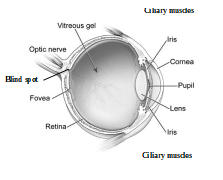Human Vision
Objectives
- See how the human eye works by studying a model eye
- Use the eye model to simulate and correct an eye with the following vision problems: nearsightedness, farsightedness, and astigmatism.
Resources
- Plastic eye model
- Water-filled adjustable focal length lens
- Optical rail with screen
- Various corrective lenses
- +62mm, +120mm, +400mm, -1000mm, -128mm (cylindrical), +307mm (cylindrical)
- Retina models – “normal” and bi-curved
- Meter stick, ruler
Background
 The human eye achieves vision by forming an image that stimulates nerve endings, creating the sensation of sight. Like a camera, the eye consists of an aperture and lens system at the front, and a light-sensitive surface at the back. Light enters the eye through the aperture-lens system, and is focused on the retina. The lens system consists of two lenses: the corneal lens on the front surface of the eye, and the crystalline lens inside the eye. The combined corneal and crystalline lens can be considered to be a thin lens that obeys the equation \frac{1}{d_o}+\frac{1}{d_i}=\frac{1}{f}
The human eye achieves vision by forming an image that stimulates nerve endings, creating the sensation of sight. Like a camera, the eye consists of an aperture and lens system at the front, and a light-sensitive surface at the back. Light enters the eye through the aperture-lens system, and is focused on the retina. The lens system consists of two lenses: the corneal lens on the front surface of the eye, and the crystalline lens inside the eye. The combined corneal and crystalline lens can be considered to be a thin lens that obeys the equation \frac{1}{d_o}+\frac{1}{d_i}=\frac{1}{f}
The crystalline lens is responsible for the accommodation of the eye and is controlled by the ciliary muscles. When these muscles are relaxed, a normal-functioning eye will cause the bundles of parallel light rays that enter the eye from distant objects to produce a focused image on the retina. The nearer an object is, the more divergent light rays will enter the pupil. The ciliary muscles contract to shorten the focal length of the lens, thus bringing these divergent rays into focus on the retina.
There is a limit to this accomodation at which point objects nearer to the eye cannot be brought into focus. This is called the near point of the eye, and is considered to be 25cm for “normal” vision. The far point of the eye is the greatest distance at which objects can be brought clearly into focus. In practice, anything beyond roughly 6m is considered to be infinite and denoted “normal” vision, since the change in divergence of light rays entering the pupil at distances greater than this is negligible.
A myopic, or nearsighted, eye can naturally focus divergent rays from a near object on the retina, but not parallel (or nearly parallel) rays from a distant object. This generally occurs because the eyeball is too long, and parallel light rays converge on a point in front of the retina no matter how relaxed the ciliary muscles become. Eyeglasses that correct myopia have a divergent lens, which forms a virtual image of the distant object closer to the eye.
A person affected by hypermetropia, or farsightedness, has an eye ball that is too short, making the distance from the lens system to the retina too small. This causes the image of near objects to be formed behind the retina. The near point of a hypermetropic eye is greater than normal.
A hypermetropic eye can naturally focus parallel (or nearly parallel) rays from a distant object on the retina, but not highly divergent rays from a near object. Hypermetropia can be corrected using eyeglasses that have a converging lens, which reduces the divergence of incoming rays.
Another form of vision problem is astigmatism, in which the lens of the eye is asymmetric. For example, the lens might have different curvatures along the horizontal and vertical planes, effectively having different focal lengths. This would cause details on an object to look blurry in the horizontal direction when they are brought into focus in the vertical direction, and vice versa. A correspondingly asymmetric lens must be used to correct this kind of vision problem.